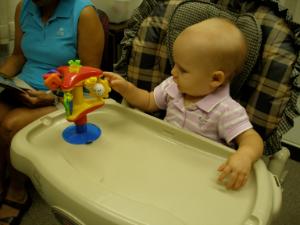Research Projects With Infants
Infant attention and distractibility: What have we learned?
We all work and learn in the midst of multiple on-going events and “noisy,” active environments…ringing phones, background conversations, televisions, unexpected noises. The ability to maintain attention, stay focused on the “task-at-hand,” and resist distraction is crucial for our everyday functioning of completing tasks, solving problems, and learning about objects and events.

Recently researchers have been interested in how infants maintain and hold their attention when a distracting event occurs in their surroundings, or in other words, when there is “competition” for their attentional focus. In the typical distractibility research paradigm used by Dr. Kannass here at Loyola, infants are given a “target toy” to explore, and while they are exploring that toy, audio-visual events (the “distractors,” e.g., colorful graphics accompanied by a beeping sound) appear on a television in their periphery. This research mimics the kinds of challenges infants and children face on a daily basis.
So what have we learned about infant attention and distractibility? In terms of developmental change, we know that there are many changes in how babies pay attention during the first year of life. For example, at about 10 months, babies are much harder to distract when they are playing with a new toy, a context where there is new information for them to learn, versus when they are playing with a familiar toy, a context where there is no new information for them to learn; just a few months earlier, babies are just as easily distracted by both new and familiar toys (Oakes, Kannass, & Shaddy, 2002). Recent distractibility research suggests that teaching infants about a distracting event may help them prioritize their attention (Kannass, Miller, & Celik, 2008). Research on infants’ and toddlers’ attention during free play attention tasks has revealed developmental change in indicators of attention span (Kannass & Oakes, 2008).
We have also learned that there is stability in attention and distractibility. In other words, young children who were more distractible at 9 months of age were also more distractible when there were 2.5 years of age (Kannass, Oakes, & Shaddy, 2006). In other work, my colleagues and I have investigated how different attention tasks may tap different underlying processes at different ages and have unique relations to other measures of cognitive ability (Kannass & Oakes, 2008). More research is needed to better understand how infants direct their attention and stability in development.


